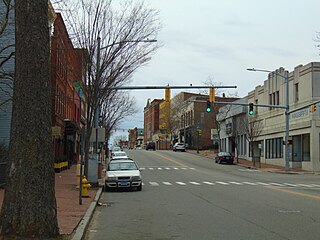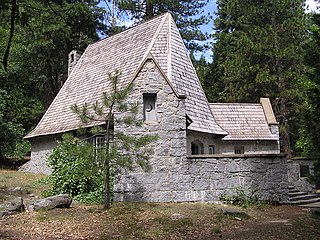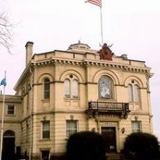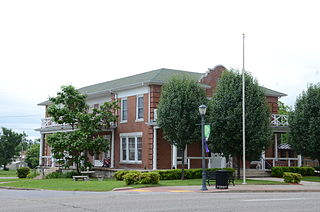
Willimantic is a census-designated place located in the town of Windham in Windham County, Connecticut, United States. It is a former city and borough. Known as "Thread City" for the American Thread Company's mills along the Willimantic River, it was a center of the textile industry in the 19th century. Originally incorporated as a city in 1893, it entered a period of decline after the Second World War, culminating in the mill's closure and the city's reabsorption into the town of Windham in the 1980s. Heroin use, present since the 1960s, became a major public health problem in the early 2000s, declining somewhat by the 2010s. Though the city was a major rail hub, an Interstate Highway has never passed within ten miles, despite early plans to connect it.

Bernard Ralph Maybeck was an American architect in the Arts and Crafts Movement of the early 20th century. He was an instructor at University of California, Berkeley. Most of his major buildings were in the San Francisco Bay Area.

The LeConte Memorial Lodge, now known as the Yosemite Conservation Heritage Center, is a structure in Yosemite National Park in California, United States. LeConte is spelled variously as Le Conte or as Leconte. Built in 1903 by the Sierra Club, it is nearly unique within the National Park Service system as a high-quality example of Tudor Revival architecture, and is an important early expression of the Club's mission. The lodge was declared a National Historic Landmark in 1987.

The Willimantic Footbridge is a pedestrian bridge in the Willimantic section of Windham, Connecticut. Built in 1906, it extends from Main Street southward, across Riverside Drive, railroad tracks, and the Willimantic River, connecting downtown Willimantic to the residential area south of the river. It is one of a small number of pedestrian bridges built in the early 20th century to survive in the state. It was listed on the National Register of Historic Places in 1979.

The Dayville Historic District encompasses a collection of mid-19th century architecture in the Dayville village of Killingly, Connecticut. It is clustered around the junction of Main and Pleasant Streets, extending along Main to High Street. The area flourished in the mid-19th century, as a consequence of the railroad being routed nearby, serving area textile mills. The district, residential except for a church, was added to the National Register of Historic Places in 1988.

The Main Street Historic District encompasses the historic portion of the central business district of Willimantic, in Windham, Connecticut. The district encompasses the commercial business district of Willimantic and is roughly linear along Main Street and Riverside Drive between Church Street and Bridge Street. It was first listed on the National Register of Historic Places in 1982. Its area was increased in 1992 to include the Hall and Bill building on North Street, built in 1889 by one of Willimantic's leading printers.

The Prospect Hill Historic District encompasses a large residential area in the Willimantic section of Windham, Connecticut. Located north of the Main Street commercial district, it was developed between about 1865 and 1930, and is one of the state's largest historic districts, with more than 800 contributing buildings. It is roughly bounded by Valley, Jackson, Bolivia, Washburn, Windham, and High Streets, and contains one of the state's largest single concentrations of Victorian-era residential architecture. It was listed on the National Register of Historic Places in 2003.

The Henry G. Brownell House was a historic house located at 119 High Street in Taunton, Massachusetts. Built in 1893, it was a high quality local example of Georgian Colonial Revival architecture. For many years it was home to the local Elks Lodge, and it was listed on the National Register of Historic Places in 1984 for its architecture. It was demolished in 2014.

The William Jillson Stone House is a historic house museum at 561 Main Street inside Jillson Square Park, in the Willimantic section of Windham, Connecticut. Built in 1825-27, it is a rare local instance of a stone house, built by one of the area's early industrialists. It is now maintained by the Windham Historical Society, and was listed on the National Register of Historic Places in 1971.

The Willimantic Freight House and Office is a historic railroad freight facility on Bridge Street in the Willimantic section of Windham, Connecticut. Built in 1870, the freight office, a fine example of Second Empire architecture, is now the only surviving element of the city's 19th-century railroad buildings; the freight house has been demolished. The buildings were listed on the National Register of Historic Places in 1982 as an important reminder of the city's importance as a major railroad junction in eastern Connecticut.

Willimantic Armory is a historic armory building on Pleasant Street in Windham, Connecticut. It served the Connecticut National Guard from 1913 until 1980 when the building was sold to developers who converted the building into apartments.

Tephereth Israel Synagogue is a synagogue at 76 Winter Street in downtown New Britain, Connecticut. The Orthodox congregation, founded in 1925, meets at a two-story brick temple with Colonial Revival and Renaissance features, designed by Hartford architect Adolf Feinberg and built in 1925. The building was listed on the National Register of Historic Places in 1995.
Ehrick Kensett Rossiter was an American architect known for the country homes he designed.

The Josiah Wilcox House is a historic house at 354 Riversville Road in Greenwich, Connecticut. Built in 1838, it is one of the town's finest examples of Greek Revival architecture. It was listed on the National Register of Historic Places in 1988.

The B.P.O. Elks Lodge is a historic fraternal lodge building at 34 Prospect Street in Hartford, Connecticut. It is a Classical Revival architecture building designed by John J. Dwyer, and built in 1903 for the local chapter of the Benevolent and Protective Order of Elks. The building was listed on the National Register of Historic Places in 1984 for its architecture.

The Elks Lodge is a historic clubhouse at 500 Mena Street in Mena, Arkansas. It is a two-story brick building, with a hip roof, marble trim, and a granite foundation. Its Colonial Revival styling includes corner quoining, porches along the front and side with square supporting posts and diamond-pattern balcony balustrade above. It was built in 1908 by the local chapter of the Elks fraternal organization, and has long been a local social venue. Between 1935 and 1951 it housed the local hospital, after which it returned to the Elks. It is also one of the community's finest examples of commercial Colonial Revival architecture.

The Bremerton Elks Temple Lodge No. 1181 Building overlooks the busy corner of Fifth Street and Pacific Avenue in downtown Bremerton, Washington. It was built in 1920 and renovated in 1947–48. It was listed on the National Register of Historic Places in 1995. It is now known as Catholic Charities' Max Hale Center.

The Windham Town Hall is a town hall in Willimantic, Windham, Connecticut.
John J. Dwyer (1856-1911) was an American architect.

Historic Hotels of America is a program of the National Trust for Historic Preservation that was founded in 1989 with 32 charter members; the programs accepts nominations and identifies hotels that have maintained their authenticity, sense of place, and architectural integrity. As of June 5, 2015, the program included over 260 members in 44 states, including the District of Columbia, Puerto Rico, and the U.S. Virgin Islands.




















